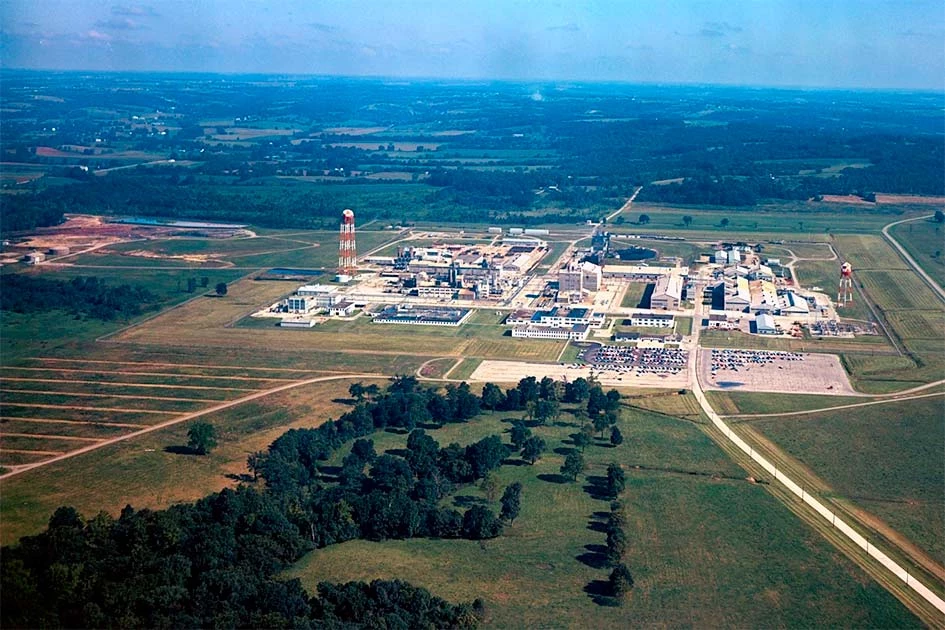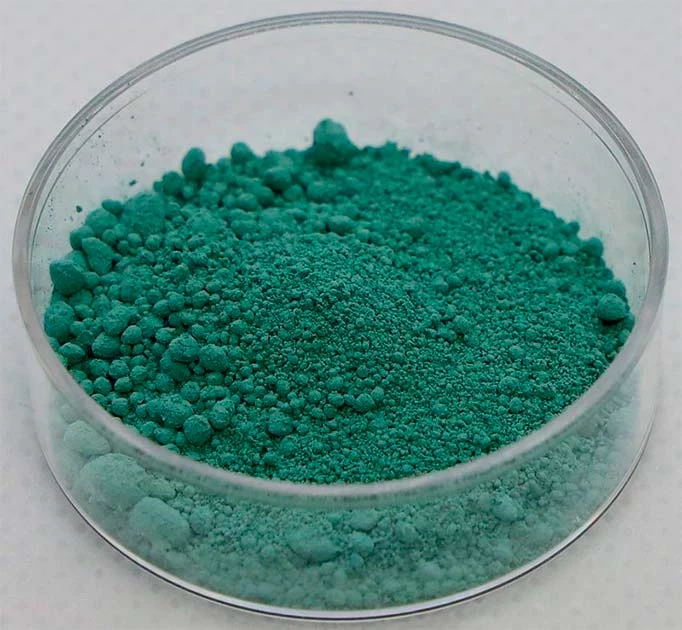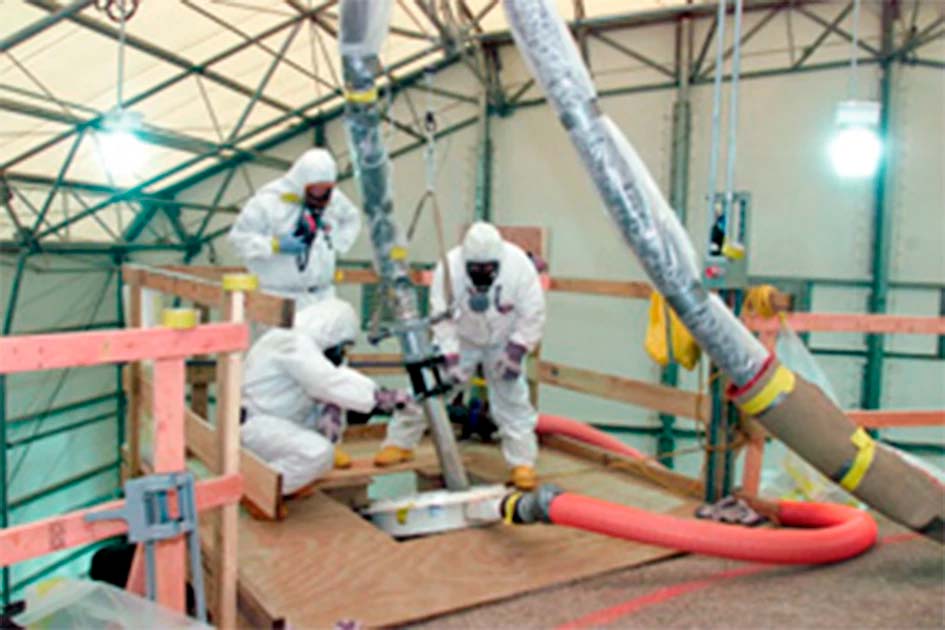David “Dave” Bocks was 39 years old when he disappeared during his shift as a pipefitter in the maintenance department at The Fernald Feed Materials Production Center. Dave’s remains were discovered inside a uranium processing furnace a few hours after he was last seen.
Was this foul play, or did this well-liked employee and father of three take his own life in the horrors of a fiery uranium furnace?
Fernald Feed Materials Production Center
The Fernald Feed Materials Production Center (commonly known as Fernald and then later by the name NLO) is a production center located within both Crosby Township in Hamilton County and Ross Township in Butler County, Ohio. The factory provided thousands of well-paying jobs to people in Hamilton County and Butler County, and people did not know much about what the Fernald Center actually produced.
Many saw the water tower on location with its red and white checked pattern and assumed that Purina owned Fernald. The logo for the Purina Dog and Cat food brand was almost identical to the design on the water tower, and rural Ohio seemed like a perfect place for a giant factory making pet food. It didn’t help that the center was called Fernald “Feed Materials Production Center,” but what was produced at Fernald was not pet food.
Fernald was a uranium processing facility that produced uranium fuel cores for the US nuclear weapons production complex from 1951 to 1989. The location of Fernald was strategic. It was located between the uranium ore delivery ports in New York and New Orleans, making it a very accessible location.

The isolated area gave Fernald a unique layer of safety and security. Even better, the site was 30 to 50 feet (9 to 15 m) above a vast water aquifer that supplied Fernald with the water needed to process uranium metals.
The employees of Fernald were told that the plant produced very low levels of radiation, and there was nothing there that would harm the workers and not to tell anyone what they were doing at work. According to one former employee who began working in 1982, everyone was required to sign a Non-Disclosure Agreement at the time of hire.
The truth was that Fernald did not produce low radiation levels; it was releasing large amounts of radioactive uranium dust into the atmosphere. This caused significant radioactive contamination of the areas surrounding the plant.
The Scandal
Between 1951 and 1989, Fernald produced 170,000 Metric Tons Uranium (MTU) of metal products and 35,000 MTU of secondary compounds like uranium tetrafluoride (known as “green salt”) and uranium trioxide. It would only be in 1984 that the public learned that Fernald had been pouring out millions of pounds of uranium dust into the atmosphere for decades.
After the factory was closed down in 1989, two medical programs were created for medical surveillance that offers services like periodic medical exams and diagnostic testing to the 12,480 members enrolled in the programs (as of January 2007). But 1984 also saw a different scandal, the suspicious death of one of Fernald’s employees Dave Bocks, a case still unsolved today.
In June 1984, Dave Bocks went missing during his night shift fitting pipes for Fernald. He was seen by multiple people, but at some point he seemed to disappear into thin air. A witness claims to have last seen Bocks sitting inside a car around 4:00 AM, “having a serious discussion with a supervisor”.
It is unknown what Bocks and the supervisor were speaking about, and the name of said supervisor has never been released to the public. The last official sighting of Bocks occurred around 5:00 AM, and it was reported that he was seen walking toward Plant 4, the “Green Salt Plant.” His remains were found inside the furnace in Plant 6, the metals fabrication plant.
- Anatoli Bugorski: Don’t Put Your Head Into A Particle Accelerator
- A Contract Killing Without Reason: Who Murdered Lindsay Buziak?
One of Dave’s coworkers/carpool buddy told police that Dave was not present in Plant 4 for a scheduled safety meeting at 7:00 AM that morning. At 7:30 AM, one furnace operator in Plant 6 reported to a supervisor that the casings in his oven were covered with a “strange, sticky residue” and mentioned a weird smell that was not typical.
The supervisor said things were fine, and the operator returned to work. Dave’s carpool buddy waited for Dave to meet him to drive him home, but he never showed up. Dave Bock’s friend reported him missing, and the facility began investigating to locate the missing man.
Suspiciously, the plant records showed a sudden 28-degree drop in temperature in a furnace in Plant 6 (the temperature was constantly maintained at 1,350 degrees Fahrenheit). The temperature change suggested that something “something ‘foreign’ had been dumped into it”.

An employee found what they believed to be a piece of bone on the lip of the furnace and called the local sheriff’s department. The furnace was immediately shut down; however, due to the extreme heat and molten liquid in the furnace, it took three days for it to cool down enough to be searched.
Employees of Fernald dug through the waste in the furnace. They found a set of keys that belonged to Dave Bock, the steel toe of a steel toe boot, a piece of glasses frame (Bocks wore glasses and was legally blind in one eye since his childhood), fragments of a walkie-talkie, and several bone fragments.
What Happened to Dave Bocks?
The investigators were unable to figure out how Dave Bocks ended up in the furnace and suggested Dave Bocks must have committed suicide. Dave Bocks had a history of psychological issues, several reports mention that Bocks was diagnosed with schizophrenia, but his symptoms were being managed by a doctor and through medication.
While schizophrenia is not a common reason for suicide, Dave Bocks attempted suicide around the time of his divorce. He lived, and according to all questioned, including his ex-wife and children, Dave Bocks had a great relationship with his ex and children.
Those who knew Dave Bocks said there was nothing to indicate suicidal intentions or even depression. They claimed that Dave did not commit suicide. Dave’s children still proclaim that their father did not commit suicide in 1984.
It is worth noting that many family members and friends of an individual who committed suicide are often in deep denial of what happened and firmly believe their loved one has been murdered. They feel like they knew the deceased well enough to notice if they were depressed or suicidal or that the deceased trusted them enough to feel comfortable reaching out if they were in mental distress.
The thing is, depression or the desire to commit suicide is not something you can easily notice in someone else (unless you are a trained psychologist/psychiatrist). Depression looks different in everyone, and many depressed individuals can mask their feelings in order to seem “fine” and act like they are not distressed.
The individual likely doesn’t want to “bother” someone else with their problems or that everyone would be better off without them and will remain silent. Could Dave Bocks have committed suicide? Possibly, suicide or murder are the only logical explanations for how Bocks ended up in a furnace.
Many members of Dave Bock’s family and coworkers insist that he was murdered and someone had to lower his body into the furnace. Some believe that Bocks knew that Fernald was releasing millions of pounds of uranium dust into the atmosphere and was killed to keep him silent.
Coworkers believe that the sighting of Dave Bocks inside a parked car engaging in serious discussion with a supervisor at 4:00 AM the day he died was Dave informing the supervisor about what he knew. Dave Bock’s family feels that he was murdered by one or more of his coworkers who had suspected him of being the whistleblower to the emissions scandal that same year, 1984.
- Ludger Sylbaris: The Man who Survived Doomsday in a Prison Cell
- What Happened to the Yuba County Five?
However, it is important to note that there is no conclusive evidence that indicates that Bock was the one who leaked information about the nuclear emissions to the public or if that is what he was speaking about when sighted at 4:00 AM.
There are a few other suspicious things about the case, which makes solving it tricky. One strange element is that Dave’s carpool buddy reported seeing his keys on his toolbox when Dave’s lockers were opened up before his body was discovered.

This friend was familiar with the set of keys, including the key to his car and opening the locks on his lockers at the facility. Yet, the keys were found in the waste of the furnace after it had cooled down three days after his disappearance. The keys were not melted.
If Dave Bocks had his keys on him when he entered the furnace, they would have melted in the furnace’s heat, but only one key (possibly his house key) was “damaged.” It is possible that the keys were thrown into the furnace right before Fernald employees searched it, but it can not be confirmed.
Finding pieces of a plastic walkie-talkie, part of a pair of glasses, and the steel toe of a boot that was not melted is also suspicious. Carbon or Stainless Steel has a melting point of over 2,600 degrees Fahrenheit (1,425 celsius), meaning the furnace was not hot enough to melt the steel in Dave’s boots.
However, the furnace took three days to cool down, which might have been enough time for the steel to melt. Why there was only one steel toe found is a mystery. The other materials should have melted if they entered the furnace when Dave Bocks did.
Regarding the bone fragments, their discovery is not massively significant, even though several articles about Dave Bock’s mysterious death mention the fragments. When a body is cremated, the temperature must be above 1,400 degrees Fahrenheit (760 degrees Celsius).
The cremation process takes around two to three hours, depending on the individual’s size and bone structure. What many people don’t know is that cremation does not turn a body into ash.

What cremation does is burn off soft tissue, water, hair, skin, organs, etc., leaving only bones behind. The bones are left to cool and then placed into a processing machine described gruesomely as “a mean margarita blender” that processes the bones down to an ash consistency, which is what the family of the cremated individual will receive.
The fragments therefore indicate that Dave Bocks was incinerated in the furnace without a shadow of a doubt. If he died because he was a whistleblower or suicidal and took his own life is unknown.
The show Unsolved Mysteries featured Dave Bock’s story in an episode. The 2019 podcast “Accused” investigates and profiles the death of Dave Bock in its third season.
It features interviews with investigators, witnesses, experts and includes an experiment with a replica of the furnace to determine if Dave entered the furnace like the detectives believe he did (running up a ladder and jumping into the furnace’s hole). If you are interested in learning more about the disturbing death of Dave Bocks, the two shows mentioned above are a great place to start investigating on your own.
Top Image: The remains of Dave Bocks were found in a uranium blast furnace which took three days to cool down. Had he killed himself, or had someone murdered him? Source: Goodwin Steel Casting / CC BY-SA 2.0.